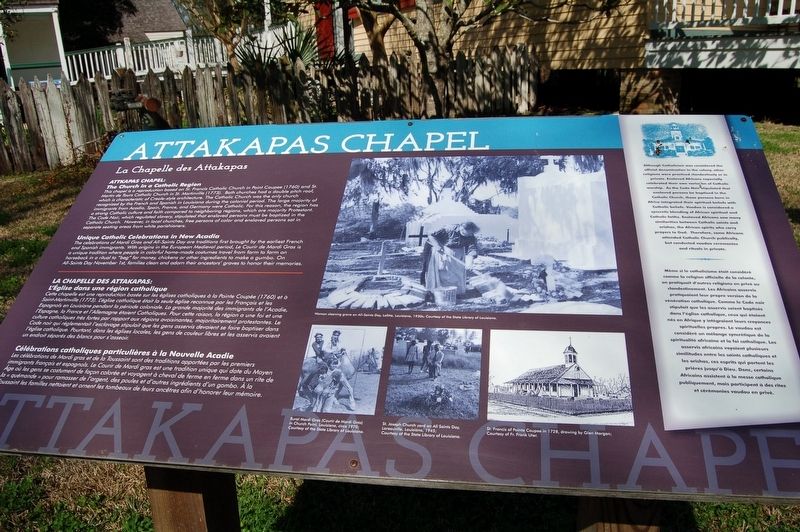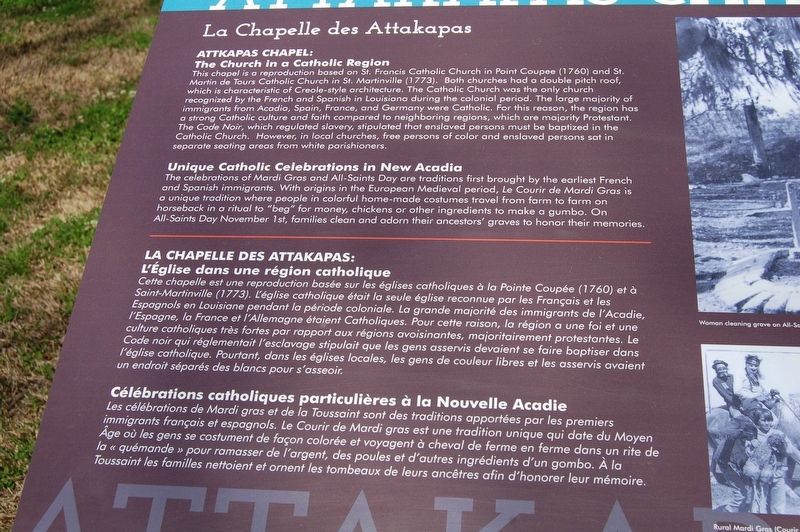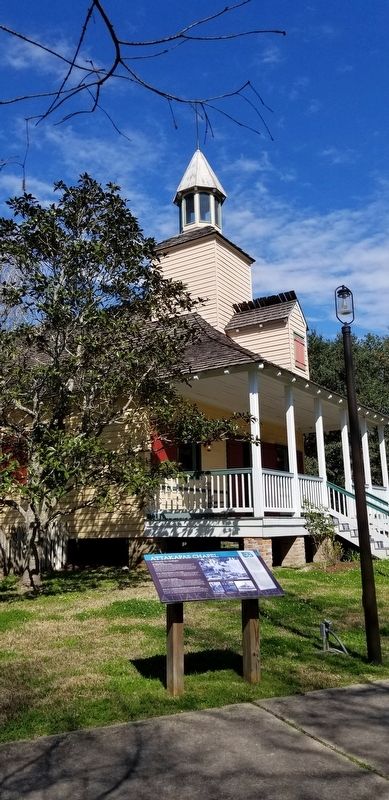Attakapas Chapel
Chapelle des Attakapas
Attkapas Chapel:
The Church in a Catholic Region
This chapel is a reproduction based on St. Francis Catholic Church in Point Coupee (1760) and St Martin de Tours Catholic Church in St. Martinville (1773). Both churches had a double pitch roof, which is characteristic of Creole-style architecture. The Catholic Church was the only church recognized by the French and Spanish in Louisiana during the colonial period. The large majority of immigrants from Acadia, Spain, France, and Germany were Catholic. For this reason, the region has a strong Catholic culture and faith compared to neighboring regions, which are majority Protestant The Code Noir, which regulated slavery, stipulated that enslaved persons must be baptized in the Catholic Church. However, in local churches, free persons of color and enslaved persons sat in separate seating areas from white parishioners
Unique Catholic Celebrations in New Acadia
The celebrations of Mardi Gras and All-Saints Day are traditions first brought by the earliest French and Spanish immigrants. With origins in the European Medieval period, Le Courir de Mardi Gras is a unique tradition where people in colorful home-made costumes travel from farm to farm on money, chickens or other ingredients to make a gumbo. On horseback in a ritual to "beg” for All-Saints Day November 1st, families clean and adorn their ancestors'' graves to honor their memories.
French
LA CHAPELLE DES ATTAKAPAS:
L'Eglise dans une région catholique
Cette chapelle est une reproduction basée sur les églises catholiques à la Pointe Coupée (1760) et à
Saint-Martinville (1773). L'église catholique était la seule église reconnue par les Français et les Espagnols en Louisiane pendant la période coloniale. La grande majorité des immigrants de l'Acadie, l'Espagne, la France l'Allemagne étaient Catholiques.
Pour cette raison, la région a une foi et unde
culture catholiques très fortes par rapport aux régions avoisinantes, majoritairement protestantes. Le
Code noir qui réglementait l'esclavage stipulait que les gens asservis devaient se faire baptiser dans
l'église catholique. Pourtant, dans les églises locales, les gens de couleur libres et les asservis avaient un endroit séparés des blancs pour s'asseoir.
Célébrations catholiques particulières à la Nouvelle Acadie
Les célébrations de Mardi gras et de la Toussaint sont des traditions apportées par les premiers
immigrants français et espagnols. Le Courir de Mardi gras est une tradition unique qui date du Moyen
Age où les gens se costument de façon colorée et voyagent à cheval de ferme en ferme dans un rite de
la e quémande pour ramasser de l'argent, des poules et d'autres
Side Panel
Although Catholicism was considered the official denomination in the colony, other religions were practiced clandestinely or in private. Enslaved Africans especially celebrated their own variations of Catholic worship. As the Code Noir stipulated that enslaved persons be baptized in the Catholic Church, those persons born in Africa integrated their spiritual beliefs with Catholic beliefs. Voodoo is considered a syncretic blending of African spiritual and Catholic faiths. Enslaved Africans saw many similarities between Catholic saints and orishas, the African spirits who carry prayers to God. Therefore some Africans attended Catholic Church publically but conducted voodoo ceremonies and rituals in private
Même si le catholicisme était considéré comme la religion officielle de la colonie, on pratiquait d'autres religions en privé ou clandestinement. Les Africains asservis pratiquaient leur propre version de la vénération catholique. Comme le Code noir stipulait que les asservis soient baptisés dans l'église catholique, ceux qui étaient nés en Afrique y intégraient leurs croyances spirituelles propres. Le vaudou est considéré un mélange syncrétique de la spiritualité africaine et la foi catholique. Les asservis africains voyaient
plusieurs similitudes entre les saints catholiques et les orishas, ces esprits qui portent les priéres jusqu'à Dieu. Donc, certains Africains assistent à la messe catholique publiquement, mais participent à des rites et ceremonies vaudou en privé.Erected by Vermilionville Historic Village.
Topics. This historical marker is listed in this topic list: Churches & Religion.
Location. 30° 12.914′ N, 91° 59.634′ W. Marker is in Lafayette, Louisiana, in Lafayette Parish. Marker can be reached from Fisher Road. Touch for map. Marker is at or near this postal address: 300 Fisher Road, Lafayette LA 70508, United States of America. Touch for directions.
Other nearby markers. At least 8 other markers are within walking distance of this marker. The Presbytery (within shouting distance of this marker); Le Petit Bayou: Ferry (within shouting distance of this marker); Buller House (within shouting distance of this marker); The Forge (within shouting distance of this marker); Trappers Cabin & Boat Shed (within shouting distance of this marker); Boucvalt House (within shouting distance of this marker); Mouton Kitchen (within shouting distance of this marker); Acadian House (within shouting distance of this marker). Touch for a list and map of all markers in Lafayette.
More about this marker. Located on the grounds of the Vermilionville Historic Village, a living history museum in Lafayette, LA. Fee is charged for access to museum grounds.
Credits. This page was last revised on November 25, 2023. It was originally submitted on February 17, 2019, by Cajun Scrambler of Assumption, Louisiana. This page has been viewed 433 times since then and 57 times this year. Photos: 1, 2, 3. submitted on February 17, 2019.


